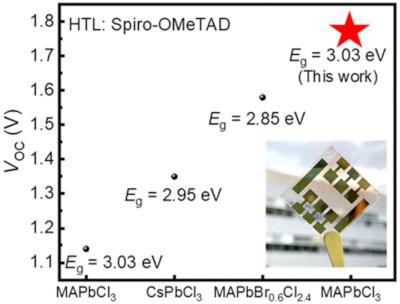Researchers from the University of Stuttgart, Forschungszentrum Jülich, Brandenburg University of Technology Cottbus-Senftenberg and University of Victoria have reported 'the highest open-circuit voltage recorded to date' for a single-junction perovskite solar cell based on hybrid methylamine lead chloride (MAPbCl3). The novel perovskite absorber was fabricated with a two-step deposition method and annealing under molecular nitrogen (N2) gas inside a glovebox.
Image from: ACS Publications
The team fabricated a single-junction transparent perovskite solar cell based on hybrid methylamine lead chloride (MAPbCl3), a perovskite material with one of the highest energy bandgaps among all perovskites. The team stated that this new cell could open the door for wide bandgap perovskites solar cells, which will be important not just for applications like Internet-of-Things (IoT) or solar windows, but also multijunction solar cells. The new work is especially noteworthy as single junction perovskites with wide bandgaps have not yet reached high voltages before.
The scientists explained that the application of this material in solar cells is limited by the fast crystallization kinetics and poor solubility
of its precursors, which results in incomplete film coverage with an irregular film morphology.
To overcome this issue, the research adopted a two-step deposition method and annealing under molecular nitrogen (N2) gas inside a glovebox. They demonstrate that the annealing atmosphere strongly influences the crystallization kinetics of MAPbCl3 without changing its bulk property. During annealing in the N2 atmosphere, the team explained, MAPbCl3 films exhibit poor surface coverage with many voids and a high root-mean-square (RMS) of around 64 nm.
The scientists designed the cell with a substrate made of fluorine-doped tin oxide (FTO), an electron transport layer (ETL) based on carbon–titanium dioxide (C/TiO2), a TiO2 mesoporous layer, the MAPbCl3 absorber, a Spiro-OMeTAD hole-transporting layer (HTL), and a gold (Au) metal contact.
Tested under standard illumination conditions, the device achieved a power conversion efficiency of 0.81%, an open-circuit voltage of 1.71 V, a short-circuit current density of 0.73 mA cm−2, and a fill factor of 64.7%.
The team stressed that a high open-circuit voltage of 1.78 V was obtained for a wide-bandgap perovskite using conventional spiro-OMeTAD HTL, noting that the open-circuit voltage is the highest ever recorded to date for a perovskite solar cell based on MAPbCl3. It was achieved with the same contacts that are used for the world-record efficiency perovskite solar cells with narrow bandgaps, and the conventional hole-transport layer spiro-OMeTAD, optimized for narrow bandgaps, managed to sustain such high voltages.


